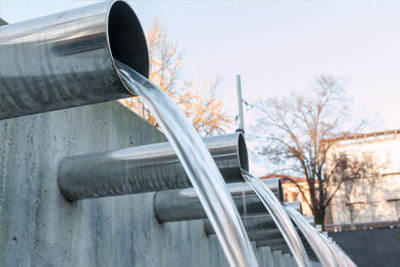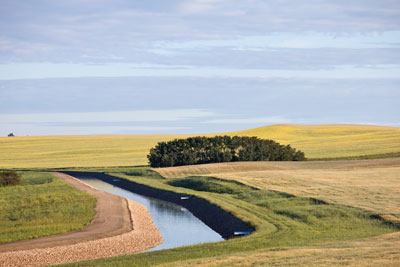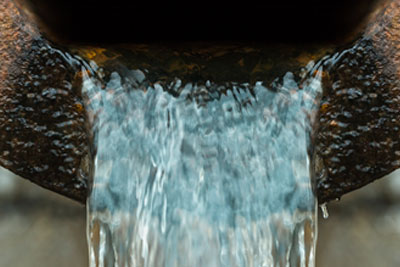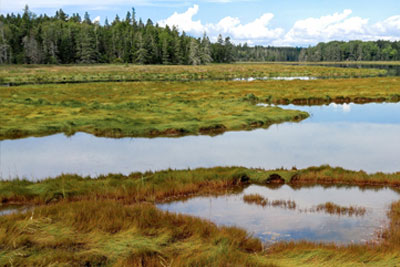





APTsorb Water Remediation Media
When Clean Water Matters
The toxin-filtering ability of peat and wetlands is well-documented, but until now, natural peat has not been a widely-accepted alternative for water treatment because of the short-comings of raw peat. APTsorb harnesses the affinity of natural peat for heavy metals, but transforms it into a hardened granule with favorable hydraulic conductivity. The media has the structural strength that is essential in water treatment processes and offers low-cost, robust treatment in challenging environments.
APTsorb is effective against dissolved heavy metals such as lead, copper, cadmium, zinc, chromium, nickel and cobalt. Additionally, the angular granular structure of the media acts as a physical filter, removing particulates all the way down to 5 microns. In many cases, APTsorb treats both suspended and dissolved metals in the same contact vessel. In the proper system design, APTsorb can be back flushed to remove solids and extend treatment life.
APTsorb solves water challenges. Contact us today to schedule a treatability test to see how APTsorb performs with your water.
Use our APTsorb Use Calculators to estimate the size of your system based on your flow rates.
Questions about how to use APTsorb? Contact our in-house experts.
Modern lifestyles require a lot of water. The average American uses 80-100 gallons of water each day and many industries use hundreds of thousands of gallons each day to manufacture the products and materials we rely on. Water is simply too precious to treat as disposable. When heavy metals and particulates are a concern, use robust, economical APTsorb to remediate contamination and prepare water for reuse or release.
Natural Sorption
The capacity and mechanisms of sorption by peat has been widely recognized. Because of the geochemical environment of deposition, peat naturally tends to reject innocuous metals such as calcium and magnesium while attracting and bonding with more toxic metals such as lead and cadmium. APTsorb captures those affinities of natural peat and transforms it into an easy-to-use granular media.
Robust Response
APTsorb can be deployed in challenging conditions that may be problematic for other resins. It tackles difficult suspended solids without fouling the media surface or compromising its sorption capacity. Add APTsorb to the front end of a water treatment train to protect valuable, high-end resins and treatments from solids. The media can be backwashed in pressure vessels to remove particulates and extend treatment life.
Highly Adaptable
APTsorb can be used in almost any water treatment configuration. Use the media in pressurized tanks, gravity feed vaults, downspout filters and booms where there is some control over flow rates and good media/water contact can be made.
Economical solution
APTsorb is a low-cost, low-input answer to complex water treatment problems. The robust nature of the media translates into less infrastructure and labor costs. Talk to our experts about how to design an effective and efficient treatment system that takes advantage of the unique characteristics of APTsorb while meeting your compliance goals.
APTsorb can be used in almost any structure, tank, vault, boom sock or in-ground cell as long as the flow rate can be controlled and good media/water contact can be made. APTsorb is cost-effective for most applications and its capacity is dependent on the metals of concern, competing ions and water chemistry. The media can also be used in a treatment train to polish water prior to discharge or to remove selected ions within the treatment system.
It meshes well with standard equipment, but there are a few things to keep in mind when considering a retrofit to APTsorb.
- APTsorb is an organic media, so it requires a certain amount of residence time. More specifically, the performance of the media is sensitive to the velocity of the water. If the water is flowing past the media too quickly, the media does not have time to form bonds with the metal ions as they travel past. Recommended velocities are dependent on the type of metal, concentration levels and background chemistry, but a general rule of thumb is to keep the velocity less than 33 ft/hr (10 m/hr). Our flow and volume calculator can give some general guidance on system designs.
- In most cases, it is preferable to keep the ratio of bed height to bed diameter less than one. A shorter, squatter contactor is preferred over a taller, thinner vessel. Given the recommended velocities above, this configuration allows for a favorable volume of water to be treated while maintaining the residence time.
- A lead/lag system will extend the life of the media as well as allow for some shortcomings in system design. The many mechanisms at work in the natural peat have different coefficients of performance, which means that the media responds robustly to different system parameters. A lead/lag system can utilize more of the different loading mechanisms than a single-pass treatment system.
- In addition to its sorptive capacity, APTsorb will act as a physical filtration media. The angular, polar surfaces of the media are very effective at sequestering solids within the bed. The efficacy of APTsorb depends on the characteristics of the solids, but removals exceeding conventional sand filters are possible.
- If suspended solids are a concern, a vessel that allows for backwashing will extend the life of the APTsorb media. Backwashing rates can vary depending on the nature of the solids, but 10-15 gpm/ft2 is sufficient to lift the APTsorb bed in most cases.
- Regeneration of the APTsorb media is not recommended. The media forms very stable double bonds with metal ions, and regeneration is usually incomplete and unwieldy. Once the media is exhausted, disposal is recommended.
- Disposal of spent APTsorb is dependent on local regulations and how the media was loaded. We recommend performing a TCLP test (EPA 1311) or total constituent analysis on the media. For most metals, with the exception of lead, under normal loading conditions, we anticipate that the media will pass the TCLP.
Contact us for more information about how to retrofit or design a system for APTsorb treatment.
- What type of water are you treating (stormwater, mine dewatering discharge, truck wash water, etc.)?
- What are the metals of concern?
- What are the concentrations of the metals of concern?
- What is the effluent target concentration?
- What volumes need to be treated?
- What flow rates need to be treated?
- What other background metals are present? (If you have any characterizations, monitoring reports, etc. that would be helpful.)
- How is the water currently being treated?
- What other treatment systems have been tried?
- What are the site limitations (small footprint, airborne contaminants, etc.)?
Contact us for more information about how to retrofit or design a system for APTsorb treatment.
Peat as a Sorption Media
Reed-sedge peat is a complex material consisting mostly of lignin, hemicellulose, cellulose and humic substances. These constituents bear functional groups such as carboxylic acids and hydroxides that are primed and ready for chemical bonding. Further, it’s the negative charge of these functional groups that make peat a star performer against toxins with a positive charge, including the cationic form of many heavy metals.
With such an extensive list of functional groups, it’s little wonder that the mechanisms of sorption for both APTsorb and natural peat remain under debate. The current literature surrounding peat typically describes five primary mechanisms of sorption.
Although definitive answers are elusive, the primary mechanisms of sorption in APTsorb appear to be complexation, chemisorption and ion-exchange.
The APTsorb Advantage
Natural peat has too many short-comings to be used as-is. Raw peat does not have favorable hydraulic characteristics because water simply doesn’t want to flow through it. As a result, when raw peat is used as a water remediation media, large amounts of sand must be added to maintain hydraulic conductivity in the bed. Also, raw peat is dusty and difficult to wet, and its low density makes shipping a challenge.
APTsorb harnesses the attractive qualities of peat while overcoming the shortfalls. APTsorb is a hardened granular media with a hydraulic conductivity of about 1 cm/sec. It is a robust media that can contend with variations in influent water. APTsorb wets readily, has minimal dust and it works without extra sand, so 100 percent of the treatment bed is dedicated to metals sequestration.
APTsorb: Under the Surface
APTsorb Product Data Sheet
APTsorb Safety Data Sheet






